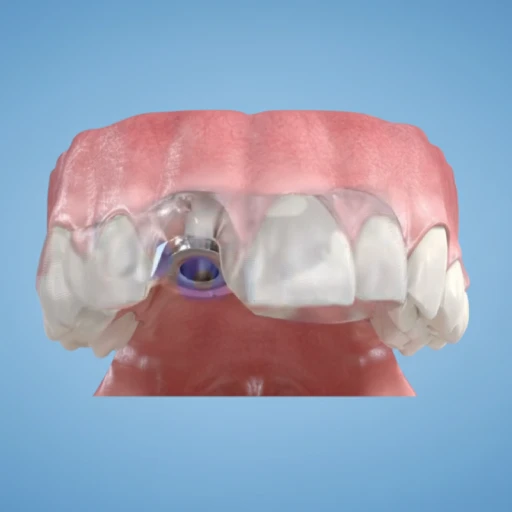Dental implant surgery is a careful process, and its success hinges on one thing: precision. When replacing a missing tooth, the implant must be positioned perfectly within the jawbone. In the past, this relied heavily on a surgeon’s eye and experience. Today, a powerful, custom-made tool has changed the game, giving dentists unprecedented control: the 3D printed surgical guide.
This guide isn’t just a fancy accessory; it’s a critical link in modern, digital implant dentistry. It translates a detailed, computer-planned strategy directly into a precise action during surgery, ensuring the outcome matches the preparation.

Why Absolute Accuracy Matters in Implant Placement
Imagine building a bridge; even a slight miscalculation in the foundation can lead to a long-term disaster. The same is true for dental implants.
Accuracy is absolutely critical for the long-term success of your implant. When an implant deviates even slightly from its ideal position, it can cause major issues:
- Damage to Vital Structures: A minor error in depth or angle could damage adjacent nerves or pierce the sinus membrane, leading to serious complications.
- Poor Osseointegration: If the implant isn’t stable or is poorly angled, it won’t fuse properly with the bone, compromising its long-term survival.
- Aesthetic Failures: A mispositioned implant makes it impossible for the final crown to look natural and function correctly.
Simply put, minimizing human error is key, and this is where a surgical guide for dental implants steps in. Its adoption is growing fast; the market for these guides is projected to reach $1.78 billion by 2031, showing just how indispensable they are becoming for high-quality care.
The Blueprint for Precision: How the Guide is Created
The creation of a 3d printed surgical guide follows a precise digital workflow, turning complex patient data into a physical tool:
- Digital Data Gathering: The process begins with advanced scanning. A Cone-Beam CT (CBCT) scan captures the bone structure and vital nerve pathways. Simultaneously, an Intraoral Scan (IOS) creates a highly detailed 3D model of the gums and existing teeth.
- The Digital Merge: These two separate scans are then fused together on a computer, creating a complete, highly accurate 3D model of the patient’s unique tooth-and-bone anatomy.
- The Prosthetically Driven Plan: The dentist or surgeon uses specialized Computer-Aided Design (CAD) software to virtually place the implant in the ideal position, specifically planning for the final crown. This plan is the backbone of the entire treatment.
- 3D Printing the Guide: The final design—which includes a tiny metal sleeve to direct the drilling—is exported and printed using advanced technologies like Stereolithography (SLA). The result is a clear, biocompatible resin guide, often referred to as surgical guide resin, that fits perfectly over the patient’s teeth, tissue, or bone.
This systematic, digital approach ensures that the final surgical guide dental tool is an exact replica of the virtual plan, promising repeatable precision.
Different Guides for Different Smiles
Not all surgical scenarios are the same, so there are different types of surgical guides for dental implants:
- Pilot Guide: Controls only the very first, small drill to establish the starting point and angle. Best for simple cases, allowing the surgeon some flexibility for the later drilling steps.
- Fully Guided: Directs *every* drill size and the final implant placement using a series of specific sleeves. Best for complex cases or when maximum accuracy is non-negotiable.
- Tooth-Supported: Rests securely on the surrounding teeth. Most common type; offers the highest stability for patients with some teeth remaining.
- Tissue/Bone-Supported: Rests on the gum tissue or is fixed directly to the bone. Best for patients with no teeth (edentulous) where stability is a bigger challenge.
While a fully guided system offers superior accuracy, even a simpler 3d surgical guide significantly improves control compared to traditional freehand methods.
The Practical Benefits: Faster, Safer, Better Outcomes
The shift from freehand surgery to using a dental implant surgical guide offers tangible, real-world advantages for both the clinician and the patient.
1. Superior Accuracy and Safety
Clinical studies show a huge reduction in errors. Fully guided protocols reduce angular deviations—the error in the implant’s angle—to 2.2 to 4.98 degrees, which is far superior to the 3.5 to 10.09 degrees often seen in freehand surgery. This precision drastically minimizes serious risks like nerve damage or sinus perforation.
2. Reduced Surgical Time and Trauma
Because the plan is finalized before the patient sits down, the procedure is streamlined. The surgeon no longer needs to take multiple measurements during the operation. This can cut the actual surgical time by 30 to 50 percent. Furthermore, these guides often enable flapless surgery (no large incision), leading to less bleeding, less swelling, and much faster recovery times.
3. Predictable and Confident Results
Pre-planning means the final restoration is considered from the very start. The optimal positioning guaranteed by the guide leads to better prosthetic integration and higher long-term survival rates for the implant. Shorter recovery times and less invasive procedures always lead to greater patient comfort and satisfaction.
Leading the Future of Implant Dentistry
The use of 3D printed surgical guides is no longer a futuristic concept; it is a foundational pillar of high-standard implant care. For dental professionals, these tools enhance precision, reduce the complexity of difficult cases, and build confidence. For patients, it means a safer procedure, a quicker recovery, and a more reliable, beautiful result.
As technology advances, future trends point toward AI-assisted planning and advanced surgical guide resin materials that might even incorporate antimicrobial properties. The goal remains the same: making implant surgery more predictable, less invasive, and successful for every patient.

